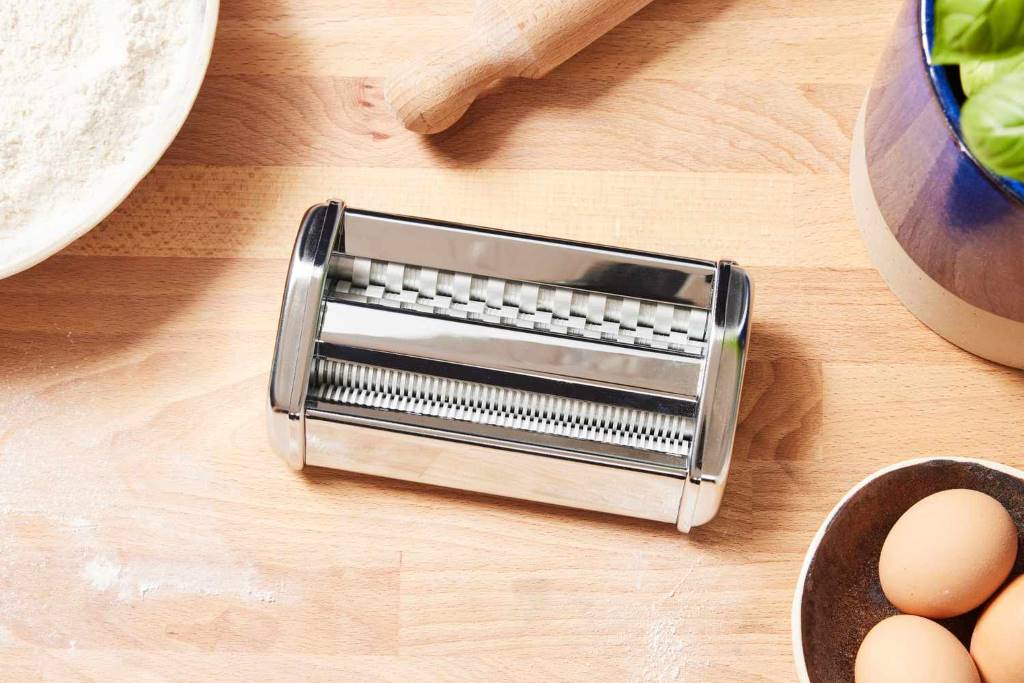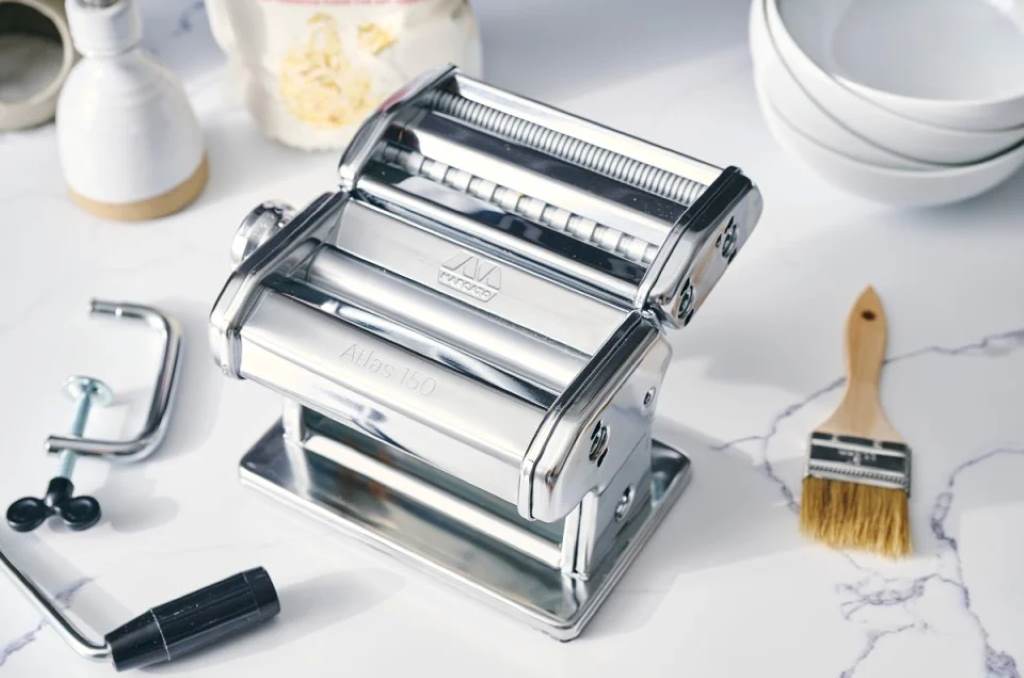You roll out fresh pasta sheets with your Marcato Atlas 150. The kitchen smells like semolina and dreams. Then, dough clings to the rollers. You reach for the sink. Stop right there. Can you wash a Marcato Atlas 150 pasta maker with water? The short answer hits hard: no, you cannot. Water invites rust and wrecks the gears.
This pasta machine, born in Padua, Italy, crafts perfect pasta shapes like fettuccine or lasagnette. It uses anodized aluminium alloy rollers for smooth food contact. But its design demands dry care. Submerge it or rinse, and moisture seeps in. Gears corrode. Rollers jam.
Pasta rules home kitchens. In the US, 269.62 million people grab spaghetti or pasta sauce yearly, per Statista data from 2020. Globally, a 2020 DOXA study for Unione Italiana Food shows 90% of Americans eat pasta weekly. That boom ties to lockdown cooking. Folks craved comfort. Home pasta making spiked 55% in UK sales that year.
This guide arms you with safe steps. Learn why water harms. Master dry methods. Boost your pasta making experience. Let’s dive in.
Why Water Spells Trouble for Your Pasta Maker
Water seems simple. But for the Marcato Atlas 150, it acts like a sneaky foe. This machine mixes chrome-plated steel cutters and anodized aluminium alloy rollers. Both shine for food-grade use. Yet, they hate trapped moisture.
Think about the build. Gears hide inside. Rollers adjust via a 10-position knob. Water slips past seals. It pools in crevices. Rust forms fast on steel parts. Once it starts, your pasta roller turns gritty. Fresh dough sticks. Shapes warp.
Otello Marcato designed it in 1935. From his Padua backyard, he built a legacy. The Atlas 150 endures manual cranks or Pastadrive motor add-ons. But carelessness ends that run quick.
Users share horror stories. One Reddit thread from 2020 details a rusty Atlas after a quick rinse. “Water got trapped,” the poster laments. “Now it jams.” Avoid that pitfall. Dry cleaning keeps your tool sharp for years.
Beyond rust, water dilutes flavors next time. Residue mixes in. Your homemade pasta tastes off. Stick to basics. Brush away flour. Wipe surfaces. Your machine thanks you with flawless sheets.
Official Cleaning Rules from Marcato
Marcato spells it out clear. Do not wash the Atlas 150 with water. Skip the dishwasher too. Their manual stresses this. Clean outer surfaces with a cloth or brush. That rule saves your investment.
Focus on the combs first. Plastic combs sit on cutters. They catch dough bits. Remove them easy. Press the rod down. Slide it sideways. Flip the machine. Hold the roller part. Pull out the combs. Rinse those alone under water. Dry them full.
For the body, grab a clean dry brush. Sweep away loose flour. Then, a microfiber cloth works wonders. Dampen it slight with vegetable oil if needed. No soap. Wipe gentle. Buff dry right away.
The anodising process protects rollers. It stops metal release into food. But water wears that coat over time. Keep it intact. Use a soft tool. Never scrub hard.
Marcato pushes food-grade Vaseline oil for stuck bits. Dab a touch. Work it in. It lifts residue without harm. Your pasta extruder machine stays pristine.
Follow these, and you roll like a pro. Lasagna sheets flow smooth. Ravioli attachments pair perfect.
Step-by-Step Guide to Clean Your Pasta Machine

Ready to clean? Follow this numbered list. It takes minutes. Keeps your Marcato Atlas 150 ready for action.
- Unplug and Cool Down: Turn off the electric motor if attached. Let the machine rest. Hot parts steam up wipes.
- Brush Loose Debris: Take a clean dry brush. Sweep rollers and cutters. Focus on cylinder ends. Flour falls free.
- Remove Attachments: Unscrew the ravioli attachment or cutter heads. Set aside. Clean each solo.
- Wipe Outer Surfaces: Use a microfiber cloth. Lightly damp with vegetable oil. Glide over food contact areas. No pooling.
- Tackle Combs: As above, pop out plastic combs. Rinse under tap. Pat dry with kitchen towel. Reinsert firm.
- Oil if Sticky: Spot dough? Apply food-grade Vaseline oil sparse. Let sit one minute. Wipe off excess.
- Dry Thorough: Air dry full. Or buff with a fresh cloth. Store in a dry spot.
- Check Gears: Peek inside. Brush any dust. Keep that area bone dry.
Do this after each use. Your pasta dough rolls even. Shapes cut crisp.
Pro tip: For heavy builds, wait till dough dries. Steel wool? Skip it. It scratches chrome-plated steel. Opt for soft tools.
Tools You Need for Safe Cleaning
Gather these basics. They make care a breeze.
- Clean Dry Brush: Stiff bristles grab flour without scratch.
- Microfiber Cloth: Traps dust. Leaves no lint.
- Kitchen Towel: Absorbs quick. Prevents streaks.
- Vegetable Oil: Loosens bits. Safe for contact.
- Food-Grade Vaseline Oil: Deep cleans without chemicals.
- Plastic Combs: Marcato’s extras. They snap in for deep reach.
Skip steel wool. It mars surfaces. No soap either. Residue lingers.
With these, you handle boiling water spills or eggy dough easy. Your machine stays like new.
Common Mistakes and How to Fix Them
Home cooks slip up. Here’s how to dodge pitfalls.
- Rinsing Under Tap: Water sneaks in. Fix: Dry wipe only. If wet, disassemble. Air out overnight.
- Using Dish Soap: Builds film. Fix: Vinegar wipe next time. But test small.
- Storing Damp: Rust brews. Fix: Full dry. Loose cover it.
- Forcing Rollers: Dough jams. Fix: Oil light. Crank slow.
One case: A user on Stack Overflow shared a jammed Atlas. Cause? Wet clean. Solution? Brush and oil. Back to fettuccine in hours.
Learn from them. Your pasta making experience levels up.
Why Choose the Marcato Atlas 150 for Homemade Pasta
This machine stands out. It rolls pasta sheets thin as paper. Adjust from thick lasagna to delicate tagliolini.
Build quality shines. Anodized aluminium alloy rollers resist wear. Chrome-plated steel cutters slice clean. Pair with lasagnette attachment for ribbons. Or ravioli stamps for pillows.
Manual or electric options fit all. Crank by hand. Or add Pastadrive motor for ease.
From Padua roots, it crafts semolina pasta or cheese ravioli. Users love it. “Best pasta roller ever,” one review gushes.
Compare to Kitchen Aid mixers. Atlas wins for focus. No bulk. Pure pasta power.
Explore Now:
- Deco Chef Automatic Pasta Maker Review: Quick, Versatile, and Convenient
- Cuisinart White PM-1 Machine for Bread, Pasta And Dough – Quick And Versatile
- CGOLDENWALL Electric Pasta Maker Review: 12 Shapes, Digital Control, 650g Capacity
Mastering Pasta Recipes with Your Clean Machine
Clean machine, fresh start. Try these.
Basic Pasta Dough:
- Mix 2 cups durum flour, 3 eggs.
- Knead till smooth.
- Rest 30 minutes.
- Roll through Atlas 150. Start thick. Thin down.
Cheese Ravioli:
- Fill with ricotta, spinach.
- Seal with egg wash.
- Cut via attachment.
- Boil in salted water. 3 minutes.
Semolina Pasta Tips:
- Dust with pizza flour.
- Dry on pasta drying racks.
- Store in airtight.
Your machine makes it pro-level. Invite friends. Share the joy.
Advanced Accessories for Your Setup
Level up. Grab these.
- Cutter Attachment: Five blades for shapes.
- Ravioli Attachment: Stamps 12 at once.
- Pasta Drying Racks: Air out sheets.
- Atlas Ampia: Wider roller for big batches.
- Atlas 180: Extra length for pros.
Mix and match. Your domus machine turns epic.
Troubleshooting Quick Fixes
Roller sticks? Oil it. Noise? Check alignment. Dough tears? Flour more.
Stack Exchange threads help. Search “Atlas 150 jam.” Real fixes from cooks.
Conclusion
You cannot wash a Marcato Atlas 150 pasta maker with water. Rust ruins it fast. Brush dry. Wipe gentle. Use oil smart. Follow steps, and it lasts forever.
Now, roll that dough. Craft pasta shapes. Enjoy the fresh bite. Grab your brush. Clean today. Cook tomorrow.
FAQs
Can I Use Soap on My Marcato Atlas 150?
No. Soap leaves residue. Stick to dry brush and oil. It keeps food safe.
How Do I Clean the Cutter Attachment?
Remove it. Brush teeth. Wipe with oiled cloth. Dry full. Reattach tight.
What If Dough Dries Hard on Rollers?
Let it set. Scrape with plastic comb. Dab Vaseline oil. Wipe away.
Is the Atlas 150 Safe for Food Contact?
Yes. Anodized rollers and steel parts meet standards. No harmful release.
Can I Attach a Motor to Atlas 150?
Yes. Pastadrive motor fits. It powers through thick dough easy.





Leave a Reply